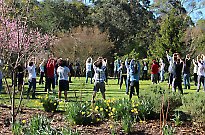
Are you turning your back on organised religion?

Today we have a world of choices before us
An increasing number of Australians are turning their backs on organised religion and seeking non-religious spirituality in their lives, writes David Goding.
It’s an unusual state of affairs when you consider that previously a spiritual person would, by very definition, have a strong religious affiliation. To be spiritual meant you were a believer.
Today, this is not necessarily the case.
“People find and make meaning in all sorts of different ways,” says Macquarie University’s Professor Marion Maddox, a leading authority on religion in Australia.
“It could be about expressing their spiritual connectedness to one another, to their place in the world, to the seasons, to what they feel are rules about appropriate behaviour.”
It may also involve religion, but it may not be the typical religious involvement we commonly associate with past generations.
“People are finding forms of connections with religions that suit them, but they mightn’t look much like older forms of connections with religions,” says Maddox. “People might not go so far as to be regular members of congregations, but they still might feel attached to a denomination in a spiritual way.
“Today, like other things, we have a world of choices before us. We can make up our own version of whatever combination of elements we want to choose.”
Religion on the decline
The numbers attending Christian churches have been falling since the 1950s, slowly at first, then rapidly over the past few decades. In 1901, 99 per cent of Australians identified themselves as Christian. By 1986 this had become 73 per cent and at the last census, 60 per cent.
A further five to six per cent aligned to other religions: 2.5 per cent Buddhist, 2.2 per cent Islam and 1.3 per cent Hindu.
But perhaps the most damning statistic is that 22 per cent of Australians stated they had ‘no religion’, up from 12.7 per cent in 1986. This included 28 per cent of younger people.
Of the 60 per cent Christian majority, only around 15 per cent claims to attend church at least once a month.
“The proportion of the population that has a religious practice is now a lot smaller than in any time since Federation, and the decline looks to be continuing,” says Maddox.
“Uniting and Anglican churches have suffered particularly due to the ageing of their congregations. Attendances among their congregations are particularly high among older people, and of course, older people get even older and die, and congregations get even smaller and die.”
A new breed on the rise
Not all denominations are declining as rapidly. In fact, some churches have found a niche where there was previously only a crack. Churches that are now thriving have seemingly adapted to our changing spiritual requirements.
“Churches that create something akin to a village within a church, as opposed to the old church within a village, are experiencing a boom in attendance,” says Hugh Mackay, social researcher and author of What Makes Us Tick and, most recently, The Art of Belonging.
“Some of the so-called ‘mega churches’ now attract congregations in their thousands, and the people who attend say they appreciate the strong sense of community they find there, generated not only by being part of a large and enthusiastic congregation – the well-documented bandwagon effect – but also by participation in the many other activities on offer, designed to engage and occupy them.
“These range from weekly discussion groups to children’s activities, youth groups calibrated to particular ages, women’s meetings, music ensembles, welfare and social justice agencies and annual conferences,” Mackay says.
Pentecostal churches, such as Hillsong, are the big growth story of Australian Christendom. Surprisingly, Catholicism has also remained relatively firm in spite of the general decline in ‘old’ Christianity. Much of the growth areas, however, appear to be at the expense of other denominations, rather than attracting people who previously weren’t going to church at all.
A Christian country
On the surface, Australia appears to be an increasingly non-religious society – a fact that had the Pope warning us that Christianity was disappearing faster here than anywhere else on the planet back in 2005. But you don’t have to dig too far to find our Christian roots.
“Much of the common cultural heritage that infuses our traditions is from Christian sources,” says Maddox. “We celebrate our holidays on Christian festivals. We don’t celebrate Buddhist festivals or festivals of any other religious tradition. We are a Christian heritage nation.”
“If you ask people who are members of religious traditions other than Christianity, ‘Is Australia a Christian country?’, they will say, ‘of course’. They don’t feel like it’s part of their tradition; they feel a bit on the outer. The holidays are not their holidays and the symbols are not their symbols.
“But if you ask the same question to someone who has grown up in today’s post-Christian culture, they’d say, ‘Of course not, I don’t go to church, my parents didn’t go to church, we’re a secular country.’”
Our spiritual needs
Religions serve an important spiritual and philosophical need and, as many experts argue, were created for this very purpose.
“The desire for something to believe in is more widely satisfied by religion than by any other set of beliefs we humans embrace,” says Mackay. “Religion has always existed in human societies as a source of comfort, consolation and inspiration for those people who might otherwise be numbed by grief, or crippled by confusion about their place in the cosmos or by anxiety about the fragility of their mortal existence.”
Religion is also about the desire to connect and belong, says Mackay.
“Local parish churches used to act as social as well as spiritual hubs for the neighbourhood,” he says. “They were places where the community gathered – not just for church services, weddings, baptisms and funerals, but also for fetes and festivals, dances, concerts, Sunday school classes, and even sport.”
With so many of these church communities shutting down or running on rapidly dwindling numbers, it could be concluded our spiritual needs are not being met by traditional means. How then are we expected to get our spiritual fix in the modern world?
In Religion for Atheists, philosopher Alain De Botton suggests that non-believers steal some of the spiritual traditions of religion in order to give their lives more spiritual meaning.
“The challenge facing atheists is how to reverse the process of religious colonisation,” he says. “How to separate ideas and rituals from the religious institutions which have laid claim to them but don’t truly own them.
“Our soul-related needs are ready to be freed of the particular tint given to them by religions.”
Finding your spiritual home
In today’s society you can have religion with or without a side of spirituality, just as you can have spirituality without the added religious doctrine. But what spirituality means to you and how you achieve a sense of spirituality in your life may be completely different from the next person.
“People can find meaning or spiritual connectedness through a host of different activities,” says Maddox. “It might be a yoga practice or something like investing food practices with a lot of meaning and significance. Whether it’s veganism or eating seasonally or the sense of community around the table, there are a million different ways that people can interpret their eating with an extra layer of meaning. And that’s just food.
“For some people it might be a fitness regime. They feel they have to train to a certain timetable or plan which gives it an aura of sacredness or religious authority.”
Meditation, common to most of the world’s religious traditions in one form or another, can also be a deeply non-religious spiritual experience.
“For some people, the most effective way to connect with ourselves is through disciplined meditation,” says Mackay. “They believe that when we are deeply relaxed, unencumbered by stress and distraction, we experience a heightened sense of self-awareness and are more closely in touch with our inner being.”
Developing a sense of spirituality needn’t be hard work. In fact, one of the best ways to connect with your spiritual side is creative play.
“When you are engrossed in the artistic process – writing, taking photographs, composing, playing or singing music, dancing, painting, sculpting, drawing or creating any kind of art or design – you are lost to your surroundings,” says Mackay. “The therapeutic and connective benefits of the creative process seem so powerful to those who engage in it that it’s a wonder any of us holds back.”
You might like: Spiritual retreats in Australia or How to start afresh


